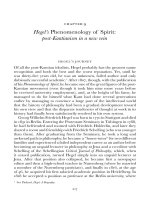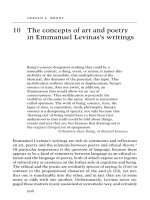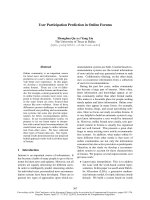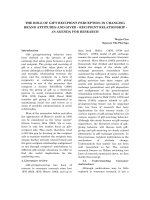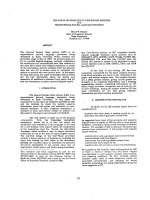Organization¿s adoption of user initiated innovations in online brand communities
Bạn đang xem bản rút gọn của tài liệu. Xem và tải ngay bản đầy đủ của tài liệu tại đây (624.74 KB, 62 trang )
Organization’s Adoption of User-Initiated Innovations in Online
Brand Communities
Mingguo Li
May 2011
Master of Science Thesis
Department of Information Systems
School of Computing
National University of Singapore
Supervisor: Seung Hyun Kim
Abstract
Online brand communities for innovation have been launched by companies in order to collect innovation
ideas from their customers in the past few years. This phenomenon could potentially transform the
relationship between a company and its customers from the traditional producer-buyer relationship to that
of co-creators of value. Adopting innovation ideas from its customers reduces the new product
development cost and improves company’s image and its customer relationship. However, until today,
theoretical and empirical research investigating adoption of innovations in such brand communities for
innovation is limited. This study examines the factors that influence an idea being adopted by a company.
Drawing on Diffusion of Innovations (DOI) theory and Elaboration Likelihood Model (ELM), we have
developed a theoretical model to explain the adoption decision of a company based on directly observable
source and innovation characteristics. In particular, we examine the effects of contributor’s prior
participation, prior adoption rate, the innovation’s popularity and supporting evidences. We also highlight
the differences between B2C (Business-to-Consumer) and B2B (Business-to-Business) contexts in the
effects of such factors in determining the adoption likelihood of an innovation idea. Our theoretical model
is validated by analysis using logit regression on secondary data of 19,964 customer innovation ideas
collected from Salesforce.com IdeaExchange and Dell IdeaStorm websites. The results show the
significant impact of both sources and innovation characteristics on the adoption likelihood of customer
innovation. Our finding suggests that brand community practitioners can attract more valuable innovation
ideas by encouraging experienced users to make more contribution and facilitating the idea contributors to
provide supporting evidences to elaborate on their ideas.
Keywords: Brand Community, User Innovation, Elaboration Likelihood Model, Diffusion of
Innovations, Logit Model, Dell IdeaStorm, Salesforce.com IdeaExchange, B2B, B2C
1
Table of Contents
Abstract ......................................................................................................................................................... 1
1.
Introduction ........................................................................................................................................... 3
2.
Conceptual Background ........................................................................................................................ 8
2.1.
Diffusion of Innovation Theory .................................................................................................. 10
2.2.
Elaboration Likelihood Model (ELM) ........................................................................................ 12
3.
Models and Hypotheses ...................................................................................................................... 15
4.
Research Method ................................................................................................................................ 25
5.
6.
7.
4.1.
Data Collection ........................................................................................................................... 25
4.2.
Variables ..................................................................................................................................... 27
4.3.
Empirical Model ......................................................................................................................... 31
Results ................................................................................................................................................. 32
5.1.
Estimation Results ...................................................................................................................... 32
5.2.
Robustness Checks...................................................................................................................... 35
Discussion ........................................................................................................................................... 37
6.1.
Theoretical Contribution ............................................................................................................. 38
6.2.
Practical Implication ................................................................................................................... 42
6.3.
Limitation.................................................................................................................................... 44
Conclusion .......................................................................................................................................... 46
APPENDIX ................................................................................................................................................. 47
2
1. Introduction
Innovation is a crucial process to keep a company competitive in the market and maintain the
popularity of its products among its customers. Many companies have invested immensely in
their research and development of new products, services, and processes for incremental
improvement or radical innovation. Managing innovation could be challenging and the cost of
innovation can be considerable for each company. Every market player strives to create more
valuable innovations. Industry practitioners are concerned about how to encourage more valuable
innovations and reduce the innovation cost. The source of innovation may be internal, while
innovation ideas can also be acquired external. Whether the innovation ideas are from internal
knowledge or external source, successful innovators have to listen to the market and satisfy the
immediate requirements of consumers.
Recent studies have shown that customers can also be involved as an important part of
the innovation process (von Hippel 1976). For instance, innovations from users were bound to
generate more sales potential than traditional market research techniques (Lilien et al. 2002). By
including customers into the innovation process, companies not only benefit from lower product
development cost, but also greater market acceptance of the innovations (von Hippel 2005).
Recent years have witnessed the emergence of online brand communities for innovation. A brand
community is “a specialized, non-geographically bound community based on a structured set of
social relations among admirers of a brand” (Muniz et al. 2001). Many academic research papers
on the brand communities have proven brand communities effective to improve marketing
efficiency and increase brand loyalty (Fournier et al. 2009). The surfacing of brand community
for innovation brings to focus the potential value of brand community in the innovation process
3
of a company, as brand community can act as a valuable source of innovation ideas for the
companies.
As the pioneers to do so, Salesforce.com and Dell have launched their online brand
communities that encourage their customers to participate in the innovation process. By adopting
ideas from its customers, Dell has introduced new options to its personal computer models, such
as installing Linux as the primary operating system (Di Gangi et al. 2009) and being one of the
first companies in the industry to include many recent computer components into its models.
Salesforce.com has also ameliorated its products of Customer Relationship Management (CRM)
software by building new features adopted from its brand community. Examples of such
innovation idea are a mobile platform CRM and more customization option to generate site
reports for its clients.
The managers are interested in understanding how to maximize the value of online brand
community. Three essential questions we endeavor to answer in this research are: (1) What kinds
of customers contribute more valuable innovation ideas to the companies? (2) Which
characteristics of contributed ideas potentially influence a company’s adoption decision? (3)
What is the underlying difference in the effects of source and innovation characteristics between
B2B (Business-to-Business) and B2C (Business-to-Consumer) online brand communities? By
answering such questions, we intend to suggest a number of practical implications: should an
online brand community focus its efforts in attracting new members or retaining experienced
members? Are consumers with higher prior adoption rate more likely to contribute useful
innovation ideas to the companies? Are ideas with higher popularity considered more useful by
the company? What kinds of supplementary tools should a company provide on its brand
community to help the members better describe their innovation ideas and enhance
4
communication with the company? Should communities in the context of B2B and B2C be
maintained under the same guiding principles?
Adoption of innovations by a company has been studied from various perspectives in
prior research literature (Chwelos et al. 2001; Iacovou et al. 1995; Mehrtens et al. 2001; Rogers
1995). The context of online brand communities for innovation differs from previous research in
the following two ways. Firstly, brand plays a central role in such an innovation community.
Most members of online brand community are loyal customers enthusiastic about the brand.
They voluntarily give away their innovation ideas to their favorite brand although there are no
explicit rewards for their contributions to the brand. Interests, brand loyalty and reputation in the
community constitute the main motivations of contribution in such online brand community
(Füller et al. 2008; Li et al. 2010). Secondly, besides considerations of profitability and
feasibility of adopting a particular innovation idea, companies also consider other commercial
factors such as the impact of adoption on the activities in brand community itself, the brand
image among its most loyal consumers and the acquisition of potential customers into its brand
community. Most importantly, how an online brand community can be exploited to attract more
valuable innovation ideas has been little studied in previous literature. While prior research on
such online brand community mainly focuses on an individual customer’s motivation of
contributing innovation ideas (Füller et al. 2008; Li et al. 2010), there is a lack of study of the
factors that influence the value of innovation contribution.
Our theoretical model is built on the Diffusion of Innovations (DOI) theory (Rogers
1995) and Elaboration Likelihood Model (ELM) (Petty et al. 1986). DOI proposes that an
adoption decision can be influenced by the innovation characteristics, communication channels,
time and organizational factors (Rogers 1995). In an online brand community, when the
5
communication channels and organizational settings are constant among the consumers within
the same company, innovation characteristics account for a major part of the variation in the
likelihood of adoption. Nevertheless, DOI does not explain the influence of message
characteristics on company’s adoption decision. In this regard, ELM poses as a complimentary
explanation on the adoption decision made by a company. ELM states that adoption decision is
influenced by both central route and peripheral route processes (Petty et al. 1986). By integrating
ELM into DOI, our theoretical model includes the considerations of source characteristics, such
as individual contributor’s prior participation and prior adoption rates, as well as innovation
characteristics, including innovation idea popularity and the supporting evidences provided by
the contributor. At the same time, contributors in B2B brand communities generally possess
higher level of knowledge and longer experiences in using the products of this brand. Therefore
the contributors in B2B brand communities are more generally considered credible to the
potential adopter than contributors in B2C brand communities. Based on these observations, we
believe differences exist between the effects of above factors on adoption likelihood.
This theoretical model is tested using data collected from Dell IdeaStorm and
Salesforce.com IdeaExchange websites. A choice model (McFadden et al. 1977) is applied to the
data from two popular online communities for innovation, Dell IdeaStorm and Salesforce.com
IdeaExchange. We employ a choice model to study the adoption decision making of a company
by assuming that the company receives an expected latent benefits in adopting an innovation idea
from its customers. We have found significant effects of both source characteristics (prior
participation and prior adoption rate of a contributor) and innovation characteristics (innovation
idea popularity and supporting evidences) on the likelihood of a particular innovation idea being
adopted. More interestingly, while the positive effect of prior participation of a contributor is
6
greater in B2C (i.e., Dell IdeaStorm) than in B2B (i.e., Salesforce.com IdeaExchange), the
positive effect of idea popularity is greater in B2B than in B2C brand communities. This could
be explained by the different level of knowledge and capability to contribute, as well as the
differences in the source credibility of these two types of communities.
Our findings suggest that practitioners can benefit from more valuable innovation
suggestions from the brand community by adopting a strategy to retain its experienced members
and those members with higher adoption rates. One practical way to do so is by providing the
contributors who have a history of contributing valuable ideas with explicit rewards apart from
implicit reputation rewards inside the community. Our result further suggests that such a strategy
to retain active members may be more beneficial in a B2C context than in a B2B context.
Practitioners should also encourage customers to provide more supporting evidences on the
innovation idea, facilitating its customers to use more referenced pages and multimedia
resources, such as image and video in the description of its innovation idea. Brand community
can attract more useful innovation ideas for the company by providing supplementary interactive
tools for the customers to contribute innovation ideas. Moreover, although idea popularity has
been proved as a useful indicator of the potential value of an innovation idea, our results show
that it will be more useful to consider idea popularity as a screening tool in a B2B brand
community than in a B2C one.
The rest of the paper is organized as follows. We present the relevant literature in the
next section, followed by hypotheses development in section 3. We then describe the data and
methodology in Section 4. The results of our empirical analysis are presented in section 5.
Section 6 discusses the theoretical contributions of the results, its implications and limitations of
our findings, followed by the concluding remarks.
7
2. Conceptual Background
Innovation is described as an idea, material or artifact perceived to be new by the adopter
(Zaltman et al. 1973). In the market competition, innovation is a key process to gain competitive
advantage for the companies (Afuah 1998).Organizations that ignore new innovations run the
risk of falling into uncompetitiveness (Fichman 1999). An innovation is commonly thought to
originate from the manufacturer. However, users may also play a central role in the innovation
process (von Hippel 1976). One of the first examples of user innovation has been described by
early economist Adam Smith: a factory employee modified the working mechanism of the fireengines (Smith 1776/1999). Several studies in the 1960s show examples of user innovations,
including both minor improvements and radical innovations (Enos 1962; Freeman 1968;
Hollander 1965). In von Hippel’s research, it has been found that users play a central role in the
innovation process (von Hippel 1976). Since von Hippel’s investigation into this subject, a
substantial amount of research has been conducted to study the phenomenon of making users the
source of innovation.
Researchers of user innovation have been interested to study two central questions: (1)
why do users innovate? (2) How can producers take advantage of users as innovators? For the
first question, it has been shown that users are more likely to innovate if the innovation-related
knowledge is “sticky”, in other words, more expensive to transfer (Lüthje et al. 2005; Ogawa et
al. 2006; von Hippel 1994). Based on unique knowledge, users sometimes innovate to solve their
special needs (Franke et al. 2003; Lakhani et al. 2003; Slaughter 1993). On the other hand, userinnovators also expect themselves to benefit from their innovations (von Hippel 2005). Most of
the user innovations come from the lead-users, those users who are early adopters of new
products and whose needs portend the need of the general market (von Hippel 1986; von Hippel
8
2005). Some user-innovators benefit from selling their innovations (Foxall et al. 1984) or
become entrepreneurs (Shah et al. 2007). Besides direct benefits from innovation, user innovator
can also receive other implicit benefits from innovation, such as reputation (Lakhani et al. 2003)
and social support (Li et al. 2010).
In response to the second question, studies have shown how producers can facilitate
innovation and product improvement of the users (Douthwaite et al. 2001). There are various
ways that companies can make customers the source of innovation, such as providing the
customers with toolkits to create their own innovations (von Hipper et al. 2002), talking to lead
users during the innovation process (Lilien et al. 2002), providing virtual customer environments
(Nambisan et al. 2008), or using brand community as source of innovation (Füller et al. 2008).
Customer can also use supplementary tools such as “customer-active paradigm” (CAP) to
develop new ideas and transfer it to a producer (de Jong et al. 2009; von Hippel 1978).
A brand community is defined as “a specialized, non-geographically bound community
based on a structured set of social relations among admirers of a brand” (Muniz et al. 2001). In a
brand community, members practice in social networking, impression management, community
engagement and brand use (Schau et al. 2009). Brand community practice brings benefits to both
the company and its customers. For the company, brand community is helpful to achieve
stronger customer loyalty, higher marketing efficiency and brand authenticity (Fournier et al.
2009). The customers also benefit from practices in brand community, while their perception and
actions are influenced in brand community practices. Their knowledge can be increased and the
customers are offered a network of relationships with other customers (Füller et al. 2008).
Members of brand communities consist of a valuable source of innovation because of their
passions, experience and cooperation in knowledge generation (Füller et al. 2008). Brand
9
community provides cultural capital, produces a repertoire for insider sharing, generates
consumption opportunities and reveals brand community vitality (Schau et al. 2009).
Nonetheless, until now little research has been conducted to examine the factors that influence
the value of innovation ideas from online brand community.
2.1.
Diffusion of Innovation Theory
Adoption of innovation in an organization is an organizational decision to utilize a specific
innovation. Diffusion is defined as “the process by which an innovation is communicated
through certain channels over time” (Rogers 1995). Compared to individual’s technology
adoption decision, organization’s decision making process takes longer time. It requires complex
interactions among different roles in an organization (Fichman 1992; Rogers 1995). The study in
innovation diffusion profits from contributions from multiple disciplines, such as sociology,
education, marketing, organizational science, economics and many others.
In the most established model of diffusion of innovations (DOI) (Rogers 1995), the
elements that influences adoption of an innovation include innovation characteristics,
communication channels, time and social systems. The innovation characteristics have been
investigated in several studies. In the classical model of diffusion, Rogers (1995) proposed five
such characteristics, including relative advantage, compatibility, complexity, trialability and
observability. These characteristics of innovation are believed to affect an individual’s decision
on innovation. An individual’s decision on adopting an innovation goes through five stages: (1)
knowledge, (2) persuasion, (3) decision, (4) implementation, and (5) confirmation (Rogers
1995). The innovation adoption decision in a company can be influenced by characteristics of
user-community, organization, technology, task, environment (Kwon et al. 1987) and its industry
(Robertson et al. 1986). At the same time, as companies obtain technology only when they
10
possess sufficient technical know-how, knowledge and organization learning can act as potential
barriers in an organization’s adoption of innovations (Attewell 1992; Fichman et al. 1997). The
factors that affect the diffusion and adoption of IT innovation can be innovation-specific
characteristics, organization (context) characteristics, and those factors that pertain to a
combination of innovation and organization (Fichman 1999; Meyer et al. 1988). In an online
brand community for innovation, a company chooses to adopt the innovation ideas that are
considered feasible and profitable for the company.
The usage of DOI can be found in various IS publications. Swanson (1994) applied DOI
to the study on organizations’ adoption of IS innovation by proposing a three-core model of
innovation, which includes technical core, information systems core and administration core.
Grover el al. (1997) has tested this three-core model in adoption of ten IS innovations. Iacovou et
al. (1995) identified organizational readiness, external pressures to adopt and perceived benefits
as main influences on the adoption of Electronic Data Interchange (EDI) in small companies.
Forman (2005) applied DOI to study the variation in companies’ decisions to adopt the Internet.
Fichman (2001) developed aggregation measures to study the adoption of software process
technologies of companies. Besides, DOI has also been adopted to study the assimilation of
knowledge platforms in organizations (Purvis et al. 2003). Although institutional pressures may
play a role in a company’s innovation adoption decision, we conclude that the relative advantage
of an innovation, which is comparable to the perceived usefulness of technology in an individual
adoption decision context, is the single most important reason for adopting innovation for a
company.
A research done by Di Gangi et al. (2008) has investigated the factors that influence a
company’s adoption decision in brand community. In this research, components of Roger’s
11
Diffusion of Innovation Theory (Rogers 1995) have been utilized to study the variables that
influences a company’s adoption decision. The variables include perceived relative advantage
and compatibility, as well as the extent of change agent’s promotion efforts. Using ANOVA
tests, the researchers have relied on data collected from Dell IdeaStorm and subjective
assessments of the adopted ideas to investigate the research hypotheses. The result shows that
adoption decision of a company is based on its ability to understand the innovation and to
respond to community concerns. However, this research does not investigate the impact of other
informational influences such as reference page, supplementary image as well as the distinction
between B2B and B2C brand communities. Our research intends to investigate these unanswered
questions using more objective measures.
2.2.
Elaboration Likelihood Model (ELM)
While the DOI is a useful first step to understand the intentions of adoption, it does not
completely address the question on the influence process itself. The influence process is
particularly important in the context of online brand communities for innovation since innovation
is described in the form of a message and webpage constitute the principle way of
communication between the customers and the company in online brand communities. That is,
while the same suggestion for innovation can be made by different community members, the
likelihood of adoption by a company may differ since one’s suggestion may appear to be more
persuasive than others in a certain context but less so in other context. To fill this gap, we
employ the Elaboration Likelihood Model (ELM). ELM has been widely used in understanding
an individual’s adoption behavior where the influence process plays an important role (Sussman
et al. 2003).
12
ELM was firstly developed by Petty et al. (1986) to investigate the different levels of
influence results across various individuals and contexts. The central idea of ELM is that
different message recipients elaborate cognitively on a particular message to a different degree
by allocating more or fewer cognitive resources.1 The variations of elaboration likelihood
influence the result of adoption in turn. In ELM, attitude changes might be caused by two routes
of informational influence: the central route, in which a person makes decision after thoughtful
consideration of a communicated message or argument, and the peripheral route, in which
attitude change is a result of some simple cue without necessitating scrutiny (Petty et al. 1986).
The influence process of information is a result of a complex mixture of both central and
peripheral route processes (Petty et al. 1986). As elaboration likelihood increases, central route
makes an increasingly significant impact on recipient’s attitudes and beliefs. The central route is
more stable, enduring and predictive compared to peripheral route. The peripheral route relies on
cues regarding the behavior of target, such as source’s attractiveness, likeability and credibility.
Peripheral cues are informational indicators that are used to evaluate the content in the absence
of substantial argument processing through central route. The prior research has found that
elaboration likelihood of an individual can be increased in the workplace by changing the
message, the source or the influence context (Bhattacherjee et al. 2006). The impact of peripheral
cues in the persuasion context has been found to increase when a person as a receiver is less
involved with an issue, or an issue is less relevant to a receiver as a result of low elaboration
(Rhine and Severance 1970, Caiken 1980).
1
Elaboration is a defined as “the extent to which a person thinks about the issue-relevant arguments contained in a
message” while elaboration likelihood refers to the extent to which “conditions foster people’s motivation and
ability to engage in issue-relevant thinking” in a given persuasion context (Petty and Cacioppo 1986).
13
The study on ELM has been conducted in several different disciplines, including social
psychology (Petty et al. 1981; Petty et al. 1986; Petty et al. 1995) and marketing (Lord et al.
1995). In the field of information systems, ELM has been employed to study the impact of users’
participation in designing an expert system on the acceptance of system’s recommendation (Mak
et al. 1997). Dijkstra (1999) has adopted ELM to investigate why some users may have tendency
to agree with incorrect advice given by others. ELM has also been used to study knowledge
adoption via electronic mail-based communications (Sussman et al. 2003). Tam et al. (2005)
have adopted ELM to study the persuasion effect of web personalization. Besides, Bhattacherjee
et al. (2006) have studied the acceptance of information technology by using ELM. Cheung et al.
(2008) leveraged ELM to study the extent to which opinion seekers are willing to accept online
consumer review.
While most previous uses of ELM have been applied on the decision making process of
individuals, ELM has also been adopted to study the decision made by organizations, such as
companies (Eckert et al. 1997; Lohtia et al. 2003). Compared to an individual’s decision making
process, companies make their adoption decision through a more complex process. More people
with professional expertises are also involved in the process. Nevertheless, ELM is also
applicable to the decision making in the context of organization because the decision based on
individual evaluators’ judgment can be also affected by information process, including both
central and peripheral routes of information. In an online brand community for innovation, since
webpages serve as the the principle medium of communication between the company and its
customers, the informational characterstics on a message, such as inclusion of hyperlinks to other
sites, as well as images and other informational sources would have a significant impact on the
company’s decision making process. Eckert et al. (1997) claim that in the settings of companies
14
as customers, high visioning companies process the selling companies’ message more deeply
while stagnant management is less likely to consider the core message of persuation. Lohitia et
al. (2003) applied ELM to study the differences between business purchase decision and
customer purchase decision.
3. Models and Hypotheses
Our research integrates the DOI theory with ELM to build a theoretical model of innovation
adoption for a company. These two models complement each other in understanding the two
channels of influences on a company’s adoption decision. Prior use of ELM has mainly focused
on the adoption decision of an individual by integrating ELM with individual-level technology
adoption based on Technology Adoption Model (TAM).
We consider a customer-initiated innovation idea valuable and advantageous to a
company if it has been adopted by the company, which is put forward by the DOI. As the
adoption of the innovation idea usually requires the company’s investment of resources and
efforts, the adopted innovation ideas must be considered having potential commercial value for a
company. Thus, the inherent value of innovation represented by innovation characteristics is a
major determinant of adoption likelihood. However, the adoption decision of a company in an
online community for innovation can also be shaped by the influence process at the same time. A
few facilitators and moderators of innovation communities will do the first screening. These
early facilitators are likely to be affected by the influence process. Even the later review of a
particular innovation idea by a company’s committee to decide its adoption is biased by the
number of other community members who favored it as a signal of its potential value. Therefore,
a better understanding of a company’s innovation adoption can be achieved by consideration of
the influence process as well as the characteristics of innovation.
15
In this study, we do not intend to provide an exhaustive list of the factors that affect the
adoption likelihood of an innovation idea in online brand communities for innovation. Instead,
we focus on the effects of two source-related characteristics (i.e., prior participation and prior
adoption rate of members) and two innovation-related characteristics (i.e., idea popularity and
supporting evidences) that are of practical implications due to their direct observability by
community managers. In addition, we aim to study how a distinct context of such communities
(i.e., B2B vs. B2C) may moderate the aforementioned effects.
Prior Participation
In an online brand community for innovation, the members have
distinct participation histories in the community. Previous research has attested the impact of
prior experience on the adoption attitude of message recipients (Bhattacherjee et al. 2006; Petty
et al. 1986). The practice of online brand community members can be seen as a process of
informal learning. Informal learning is “the activity involving the pursuit of understanding,
knowledge or skill which occurs without the presence of externally imposed curricular criteria”
(Livingstone 2001). Customers informally learn about the brand and its products from their
participation in the brand community. This informal learning process through participation in the
brand community enables an individual member to better understand the innovation ideas
contributed by other members in the community. Participation in brand community enhances
individual’s understanding of the company’s values, market orientation and present needs. In
addition, the participants’ knowledge on the company’s products and the industry trends expands
by repetitive interactions with a community’s moderator and other members. Such knowledge
can be transformed into a greater level of relevance and practicability of their innovation idea
contributions. Furthermore, by observing the adoption status of others’ innovation ideas and
comparing various ideas contributed in the brand community, members with higher prior
16
participation are also expected to develop higher critical thinking skills and apply these skills in
their product innovation. Consequently, an innovation idea contributed by a customer with
higher prior participation tends to provide potentially higher relative advantage and compatibility
to the company. According to the Diffusion of Innovation theory (Rogers 1995), higher
perceived relative advantage and compatibility enhances the probability that a company adopts
an innovation idea.
Besides an explanation in DOI, the impact of higher prior participation could also be
explained in the theory of ELM (Petty et al. 1986). Apart from the above factors which are
related to the central route in the ELM, it is notable that prior participation may also function as
the peripheral cue to some adopting organizations. If a company’s review committee of
innovation ideas perceives that members’ cumulative participation improves their ability to
describe and propose more valuable innovation ideas, the company is more likely to use brand
community members’ prior participation as a peripheral cue. This case is more likely when a few
review committee members have to examine a substantial number of ideas in a short period of
time. Therefore, the effect of prior participation on the adoption likelihood will be reinforced by
its possibility of being used as a peripheral cue.
Both DOI and ELM have confirmed the positive impact of higher prior participation on
likelihood of adopting an innovation idea in an online brand community. With such observations,
we propose our hypothesis.
H1: An innovation idea contributed by a customer with higher prior participation is more
likely to be adopted by a company.
Prior Adoption Rate
A company regularly selects among the candidate innovation ideas
from brand community to implement. The prior adoption rate of each contributor varies across
17
individuals and changes over time for each individual contributor. The prior adoption rate of an
individual contributor discloses information on several aspects of the contributor of innovation
idea. A contributor more knowledgeable on the brand and its products usually has higher prior
adoption rate than others. Likewise, such a contributor with higher prior adoption rate is also
likely to possess greater inherent capability to develop valuable and relevant innovation ideas for
the company. These observations show that innovation ideas from a contributor with higher prior
adoption rate are expected to be of higher relative value and relevance.
From another perspective, an innovation contributor considers it more worthwhile to
contribute and her contribution is more likely to attract the attention of potential adopters when
her previous adoption rate is higher. The self-efficacy of a contributor can also be enhanced if
the company chooses to adopt her innovation idea. Self-efficacy positively affects an
individual’s motivation in contributing knowledge (Bock et al. 2002; Kankanhalli et al. 2005).
Existing literature supports the view that self-efficacy improves individual’s motivation
(Bandura 1988) and work-related performance (Stajkovic et al. 1998; Taylor et al. 1984). Higher
self-efficacy of idea contributor leads to higher quality of an idea contribution. As a result, the
usefulness of an innovation idea is expected to increase with individual’s prior adoption rate. In
DOI, with higher perceived usefulness and compatibility, an innovation idea is more likely to be
adopted by a firm.
The above arguments support the positive impact of prior adoption rate following DOI.
This positive impact can also be explained in ELM alternatively. An individual’s prior adoption
rate can affect the adoption likelihood through a peripheral cue. As we have explained
previously, a review committee member of a company may perceive that prior adoption rate of
the innovation idea contributor is a useful signal to judge the attractiveness, credibility and
18
potential value of an innovation idea under time constraints. This line of reasoning also
reinforces the positive relationship between the prior adoption rate and the adoption likelihood of
a proposed innovation idea. These observations lead to our second hypothesis.
H2: An innovation idea contributed by a customer with a higher prior adoption rate is more
likely to be adopted by a company.
Idea Popularity
A brand community consists of the group of customers enthusiastic
about the brand (Fournier et al. 2009). Because of brand community members’ identification to
the brand and their fondness of its products, many brand community members are anticipated to
be among the first adopters or users of a company’s latest innovation products. With these
observations, the popularity of a prospective product innovation idea in the online brand
community can often be seen as a good indicator of its potential acceptance by the future
customers as well as its potential popularity in the market. Therefore, the popularity in a brand
community suggests to the company the potential market acceptance of a potential innovation
idea.
In the online brand communities of this study, members are allowed to indicate their
preferences on an innovation idea by “promoting” or “demoting” the idea on the website. As an
innovation idea is only promoted when it is supported and considered favorable by another
customer, an idea with high voting score can be seen as a popular innovation idea in the brand
community. This feature of voting inside a brand community enables a company to gauge the
potential acceptance and popularity of a particular innovation idea among its most loyal
customers. This voting feature to some extent allows the market value of an innovation idea to be
more observable by the company. According to DOI, an innovation idea that is perceived to be
more useful and brings potential relative advantage over its competitors is more likely to be
19
adopted by a company. So an innovation idea contribution which is supported by a larger number
of brand community members has higher probability of adoption.
In addition to the explanation of the popularity in DOI, the theories in ELM can also be
applied to interpret the role of popularity in a brand community. A company perceives the idea
popularity as a signal for future popularity, which could become a screening measure for
adoption. Therefore, the idea popularity can be seen as the peripheral cue in case of constraints
due to time and resources. Using idea popularity as a peripheral cue, a company is more likely to
adopt an innovation idea with higher popularity. With the above expectations, we propose the
following hypothesis.
H3: A more popular innovation idea is more likely to be adopted by a company.
Supporting evidences
When a brand community member makes a contribution of product
innovation idea, the contributor may be enabled to add references to the innovation idea by
inserting hyperlinks to other web pages on the Internet. Including reference pages in an
innovation idea helps to ameliorate the quality of a message in the following ways. Firstly, since
the information presented on a referenced webpage is often written in a more formal and
professional way than the description produced by an amateur customer in online brand
community, adding reference pages to an innovation idea improved the understandability and
quality of the description. Secondly, web pages that referenced by other pages are very likely to
be selected from credible information sources, in other words, well recognized organization or
reputed websites. In this way, the credibility of an innovation idea is enhanced by including
references pages.
Previous research has suggested that higher source credibility incurs significantly more
opinion change than lower source credibility (Hovland 1951). Source credibility also has a
20
positive effect on the perceived usefulness of technology (Bhattacherjee et al. 2006). On the
other hand, enhanced elaboration on the innovation idea helps the adopting organization to better
understand the innovation idea. For a positively considered innovation idea, better
understandability leads to potentially higher perceived usefulness. In DOI, higher perceived
usefulness of a technology leads to higher chance of the innovation idea being adopted.
In prior studies, source credibility has been sometimes regarded as a peripheral cue in
ELM (Bhattacherjee et al. 2006; Sussman et al. 2003). When a potential technology adopter is
under lower elaboration likelihood, the source credibility of an innovation idea could become an
indicator influencing an individual’s adoption decision. In an online brand community for
innovation, the opinion change due to increased credibility also comes as a result of
interpretation of the message after absorbing information from the reference pages. Following
these lines of reasoning, including reference pages in an innovation idea is expected to have a
direct positive effect on both central and peripheral cues of potential adopter. Thus it increases
the innovation idea’s likelihood to be adopted.
H4a: An innovation idea with a reference page is more likely to be adopted by a company.
In the online brand communities of our study, a contributor is permitted to add images
inside her innovation idea description. An innovation idea, particular on designed products and
web pages, could often be more clearly illustrated with images. For an innovation idea with
potential market value for the companies, better description of an innovation idea helps to
improve its perceived usefulness. DOI suggests that an innovation idea with higher perceived
usefulness could have higher chance to be adopted by a company.
From another point, by including images into the description of an innovation idea, the
contributor improves the media richness within the message. Media Richness Theory (MRT)
21
suggests that richer media are generally more effective in communication (Draft et al. 1987). An
innovation idea with higher media richness is likely to draw more attention from the brand
community members as well as the company. Clearer illustration of the innovation idea leads to
better understandability. With potentially more readerships, an innovation idea with images in its
description is more observable by the company. In DOI, higher perceived observability brings
higher chance of its being selected.
Additionally, ELM also lends support to the positive impact of image in the adoption of
an innovation idea. It has been shown in prior literature that media richness moderates the effects
of peripheral cues (Short et al. 1976). Higher media richness influences adoption decision by
providing informational cues to potential adopters in assessing the innovation idea. Besides,
sometimes higher media richness also improves the central route of information influence by
improving the argument quality of the innovation idea and providing further details on this idea.
Hence, we hypothesize the following.
H4b: An innovation idea with supplementary image is more likely to be adopted by a company.
Business-to-Business (B2B) vs. Business-to-Consumer Community (B2C)
As shown in
other contexts, the aforementioned relationship can be moderated by the characteristics of source
or information providers. We highlight the difference in sources of innovation between businessto-business relationship and the one of business-to-consumer. Business-to-business (B2B)
environments involve transactions between two companies, while business-to-consumer (B2C)
relates to transactions between a company and an individual end consumer.
Several studies have been carried out to better understand the implications of these two
different types of e-commerce communities. In the setting of online purchasing, corporate buyers
are more concerned on specific information from B2B purchasers than the information from the
22
B2C consumers (Bridges et al. 2005; Gatticker et al. 2000). Another study has shown that a
company’s announcement of B2B e-commerce has a higher effect on the return than
announcement of B2C e-commerce (Subramani et al. 1999).
An innovation contributor in a B2C community is normally an end user who is
enthusiastic about the brand and its products. However, it is very likely that this end user is not a
professional in developing and marketing these kinds of products. Providing innovations to her
favorite brand is her pastime passion but not her profession. She may possess certain innovation
skills and experiences but has not received professional training in this filed. In contrast, an
innovation contributor in a B2B community is generally professional in working with the
products of the brand. The products of the brand are often used to improve their work. She has
professional experience in this field and might have experiences using the products provided by
other companies. Generally, an innovation contributor in a B2B community is more capable of
developing a useful innovation idea.
According to learning curve theory, the amount of knowledge that can be obtained from
prior experiences is greater for novices than for experts (Adler et al. 1991). As a result, the effect
of prior participation of members is expected to be greater in B2C than in B2B communities due
to the differences in users’ initial expertise in both communities. Since a contributor is generally
less capable of developing innovation ideas in B2C, a company can expect a substantial
improvement in their capability of contributing useful innovation ideas as they learn more
through participation in brand communities. In an online brand community for innovation,
greater capability of contributing useful innovation idea leads to a greater chance that her
innovation idea is accepted by the company. This reasoning leads us into the following
hypothesis.
23
H5a: The effect of prior participation is greater in an innovation idea for a B2C online brand
community for innovation than in a B2B online brand community for innovation.
In a B2B brand community for innovation, a member is an employee or a company as a
whole with professional backgrounds and knowledge about products and services to be
purchased. Thus, B2B brand community members are more capable of describing their
innovation ideas as well as judging innovation ideas from others. Evaluating other innovation
ideas and their contributions are more likely to be considered relevant to a company as a
potential adopter in a B2B community than B2C community as well. Therefore, with more
knowledge on the products and brand, contributors and participants who vote in communities can
be considered to possess higher credibility in B2B than in B2C. In a B2B brand community,
catering to fragmented individual customers needs is more important since the volume of
business with each customer is greater in B2B than in B2C community as well. Hence, a
company engaged in a community benefits more by investing more resources in processing
messages in B2B than in B2C communities if other conditions are equal.
The moderating effect of B2B community can also be explained by ELM (Petty et al.
1986). From an ELM perspective, the source credibility of each individual contribution and
voting is higher in B2B brand community than B2C brand community. For instance, idea
popularity that is judged by a set of other users can be more credible in this environment. The
effect of idea popularity is expected to be greater in B2B as idea popularity can become a
stronger indicator of more promising ideas. As noted earlier, members in B2B can better evaluate
the value of ideas. Furthermore, the evaluation by members is more relevant and important to a
company’s business in B2B as a professional community than in B2C. B2B prescribes a high job
relevance condition, which has been emphasized as a moderator in many ELM-related studies
24
